Related Research Articles

Cooking bananas are banana cultivars in the genus Musa whose fruits are generally used in cooking. They may be eaten ripe or unripe and are generally starchy. Many cooking bananas are referred to as plantains or green bananas. In botanical usage, the term "plantain" is used only for true plantains, while other starchy cultivars used for cooking are called "cooking bananas". True plantains are cooking cultivars belonging to the AAB group, while cooking bananas are any cooking cultivar belonging to the AAB, AAA, ABB, or BBB groups. The currently accepted scientific name for all such cultivars in these groups is Musa × paradisiaca. Fe'i bananas from the Pacific Islands are often eaten roasted or boiled, and are thus informally referred to as "mountain plantains", but they do not belong to any of the species from which all modern banana cultivars are descended.
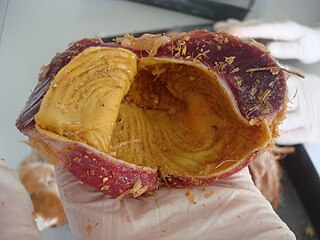
The gizzard, also referred to as the ventriculus, gastric mill, and gigerium, is an organ found in the digestive tract of some animals, including archosaurs, earthworms, some gastropods, some fish, and some crustaceans. This specialized stomach constructed of thick muscular walls is used for grinding up food, often aided by particles of stone or grit. In certain insects and molluscs, the gizzard features chitinous plates or teeth.
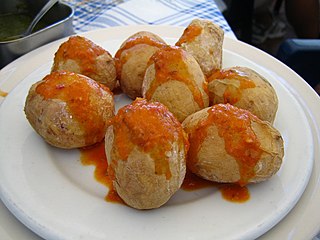
Mojo is the name, or abbreviated name, of several types of sauces, varying in spiciness, consisting primarily of olive oil, local pepper varieties, garlic, paprika, cumin or coriander, and other spices. Mojo originated in the Canary Islands, where the main varieties are green mojo, red mojo, and spicy red mojo. Other countries have recipes similar to mojo, where acidic ingredients such as vinegar, lemon, orange, or lime juice may be used.
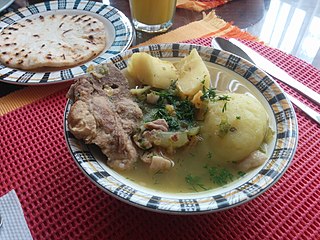
Sancocho is a traditional stew in several Latin American cuisines. Variations represent popular national dishes in Dominican Republic, Colombia, Cuba, Nicaragua, Mexico, Ecuador, Panama, Puerto Rico, Trinidad and Tobago, and Venezuela. It usually consists of large pieces of meat, tubers and vegetables served in a broth.

Sopa de mondongo is a soup made from diced tripe slow-cooked with vegetables such as bell peppers, onions, carrots, cabbage, celery, tomatoes, cilantro, garlic or root vegetables. The dish is generally prepared in former Spanish colonies in Latin America, Caribbean, and in the Philippines.

The generic term for condiments in the Filipino cuisine is sawsawan. Unlike sauces in other Southeast Asian regions, most sawsawan are not prepared beforehand, but are assembled on the table according to the preferences of the diner.

Moin-moin ( Yoruba) or moi-moi is a steamed or boiled bean pudding made from a mixture of washed and peeled beans and onions, fresh red peppers, spices, and often fish, eggs, and/or crayfish. It is a protein-rich Yoruba food that is commonly eaten across West Africa.

Ghanaian cuisines refer to the meals of the Ghanaian people. The main dishes of Ghana are organized around starchy staple foods, which goes with either sauce or soup accompanied with a source of protein. The main ingredients for the vast majority of soups and stews are; tomatoes, hot peppers and onions. Most Ghanaian soups and stews are red or orange in appearance as a result of the main ingredients used.

Picadillo is a traditional dish in many Latin American countries including Mexico and Cuba as well as the Philippines. It is made with ground meat, tomatoes, and also raisins, olives, and other ingredients that vary by region. It is often served with rice or used as a filling in dishes such as tacos, savory pastries or croquettes. The name comes from the Spanish word picar, meaning "to mince".

Dominican cuisine is made up of Spanish, indigenous Taíno, Middle Eastern and African influences. The most recent influences in Dominican cuisine are from the British West Indies and China.

Fried plantain is a dish cooked wherever plantains grow, from West Africa to East Africa as well as Central America, the tropical region of northern South America and the Caribbean countries like Haiti to Cuba and in many parts of Southeast Asia and Oceania, where fried snacks are widely popular. In Indonesia it is called gorengan. It is called ojoko in Igbo in South East Nigeria, and dodo in Yoruba in South West Nigeria, otherwise known as simply fried plantain in other parts of Nigeria. Kelewele is a fried spicy plantain or can be fried as a side dish for Red Red and fish stew in Ghana.

West African cuisine encompasses a diverse range of foods that are split between its 16 countries. In West Africa, many families grow and raise their own food, and within each there is a division of labor. Indigenous foods consist of a number of plant species and animals, and are important to those whose lifestyle depends on farming and hunting.

Nigerian cuisine consists of dishes or food items from the hundreds of Native African ethnic groups that comprise Nigeria. Like other West African cuisines, it uses spices and herbs with palm or groundnut oil to create deeply flavored sauces and soups.
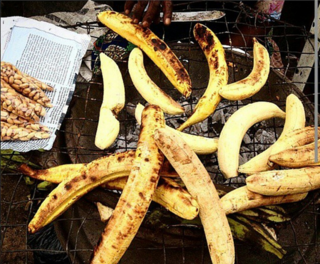
Boli is a roasted plantain snack or meal in Nigeria. It is native to the Yoruba people of Nigeria but also eaten by Rivers people due to acculturation. It is referred to as 'boli' in South West Nigeria these people are known as the Yoruba people and is eaten with groundnuts. The Yorubas have been enjoying this delicacy for ages, it can be consumed as a snack or main meal which can be accompanied with pepper sauce filled with meat, roasted fish or fried chicken especially during the festive period. The word 'boli' is being pronounced as 'bole' due to a difference in accent in the south-south region in Nigeria. In South South Nigeria, it is referred to as 'bole' and is eaten with roasted fish. Bole went from being eaten at Festivals to becoming a very popular street food. Originally it was roasted half ripped plantain and hot spicy sauce, however roasted potatoes and yam is now part of the dish. Aside from being a popular dish in Yorubaland, and Port Harcourt and environs, It is slowly becoming a staple food at homes of Rivers State people.

Dodo Ikire is a Yoruba traditional delicacy from Ikire in Osun State, Nigeria. It was originally made from leftover plantain but today, people prepare it from fresh ingredients which are: over-ripe plantains, pepper, oil and salt. Dodo Ikire is black and round or conical in shape.

Goat meat pepper soup, also referred to as nwo-nwo, ngwo-ngwo, and goat pepper soup, is a soup in Nigeria. Goat meat is used as a primary ingredient, and some versions may use crayfish. For variations boiled yams, potatoes, or plantains may be added. Versions of the soup may be spicy and hot. The soup is always served hot and is made with a blend of different spices which gives an intense spiciness and flavor to the soup. The dish has been described as being the most popular out of all the Nigerian pepper soups. It is a light soup that is often prepared without the use of oil, and may also be drunk in the style of a beverage. Owing to the ‘light’ texture of the soup, it is typically eaten alone but it can be accompanied by a side-dish known as agidi. White rice is also a common side-dish served with goat meat pepper soup. It has been described as pairing well with palm wine and beer.
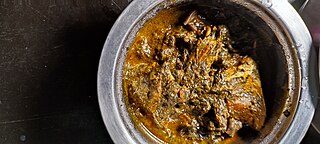
Atama soup or Amme-Eddi is also called Banga Soup in pidgin English(Nigerian English) It is a kind of palm-fruit vegetable soup that originates from the Efik people of Cross River state and Urhobo people of Delta State in South South Nigeria. It’s a popularly food among the Delta, Cross River and Akwa Ibom State People of Nigeria. The Urhobo people of Delta state called it Amme-edi or Banga soup. The soup is made from palm fruit-pulp that is derived from palm fruit; the extracted palm-pulp is base primary ingredient for the soup. Atama or Amme-edi(Banga) soup is thick and dark brown in color. It’s normally prepared with choice of protein like fresh meat or dry meat(mostly bush meat), dry fish, fresh fish and sometimes shrimp(dry or fresh), periwinkle as added proteins for more enhanced flavor. Ingredients: primary ingredients are fresh palm-pulp sourced from palm fruit, salt and pepper and secondary ingredients which are decided based on preference of the cooker are onions, salt, pepper(different kinds of pepper are preferences) and different kinds of spices could be added depending on the cooker preferred or desired taste or flavor. This soup could be styled into different flavors depending on cooking preferences. Every added ingredient could drastically change the taste of the food.
Plantain mosa is a Nigerian snack which is a component of small chops. Other components of small chops include grilled chicken, spring roll, samosa and puff puff.
Ebiripo is a steamed cocoyam common amongst the Yoruba people of Ogun state.

Asaro, also known as yam porridge or yam pottage, is a traditional dish originating from the Yoruba people of Nigeria and Benin. It is a one-pot meal made from yam, a starchy tuber, and a variety of other ingredients. It can be enjoyed as a main course or a side dish.
References
- ↑ "Gizdodo Recipe | Shoprite Nigeria". www.shoprite.com.ng. Retrieved 2022-06-23.
- ↑ "Eat Me: How To Make Gizdodo – The Whistler Newspaper". thewhistler.ng. Retrieved 2022-06-23.
- ↑ "GL Recipe: Gizdodo and Zobo". The Guardian Nigeria News - Nigeria and World News. 2016-06-11. Retrieved 2022-06-23.
- ↑ Onyeakagbu, Adaobi (2018-07-04). "Try this simple gizzard and dodo recipe". Pulse Nigeria. Retrieved 2022-06-23.
- ↑ for #OunjeAladun, Omolabake (2020-10-01). "Plantain Gizzard Kebab". Ounje Aladun. Retrieved 2022-06-23.
- ↑ Lete, Nky Lily (2013-08-11). "Dodo Gizzard / Gizdodo Recipe (Gizzards and Plantains)". Nigerian Food TV. Retrieved 2022-06-23.